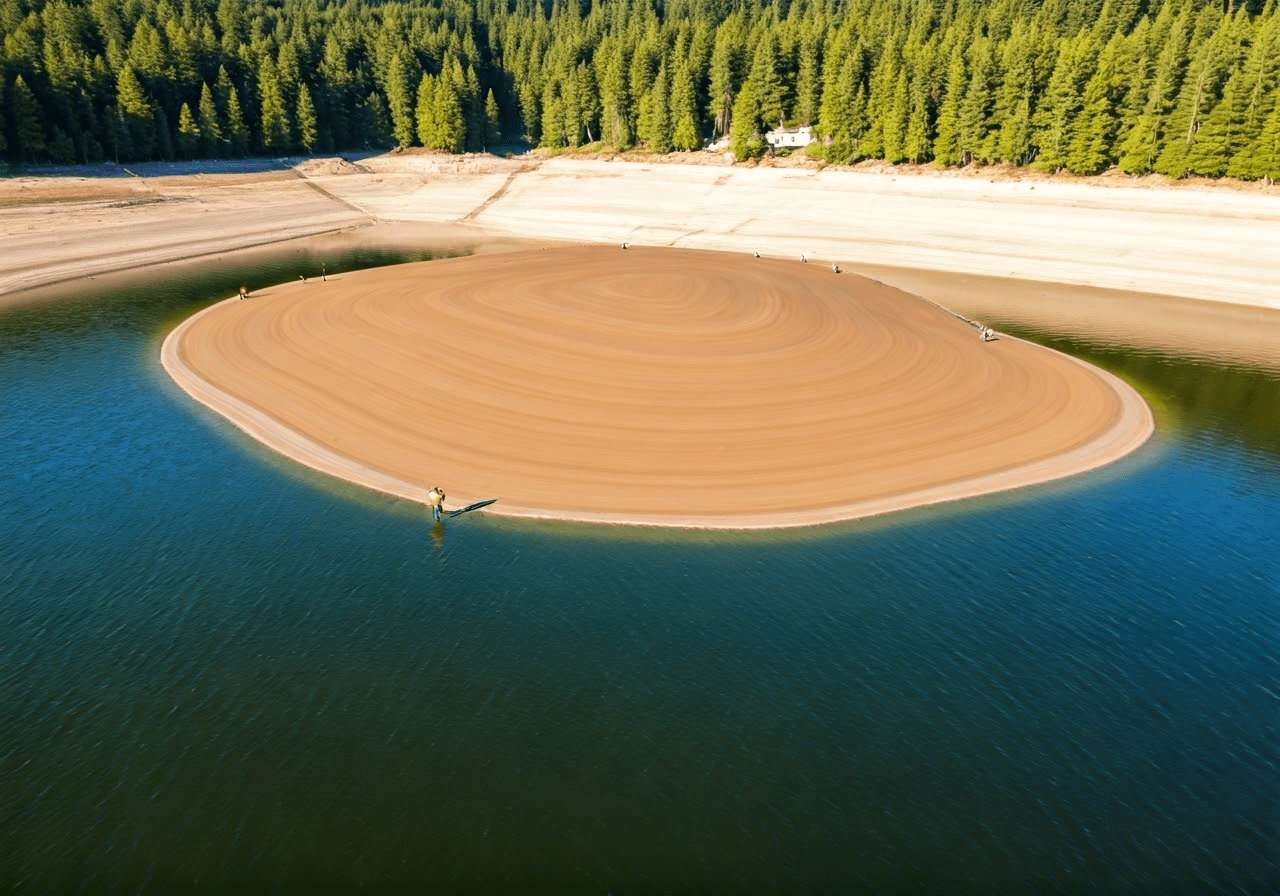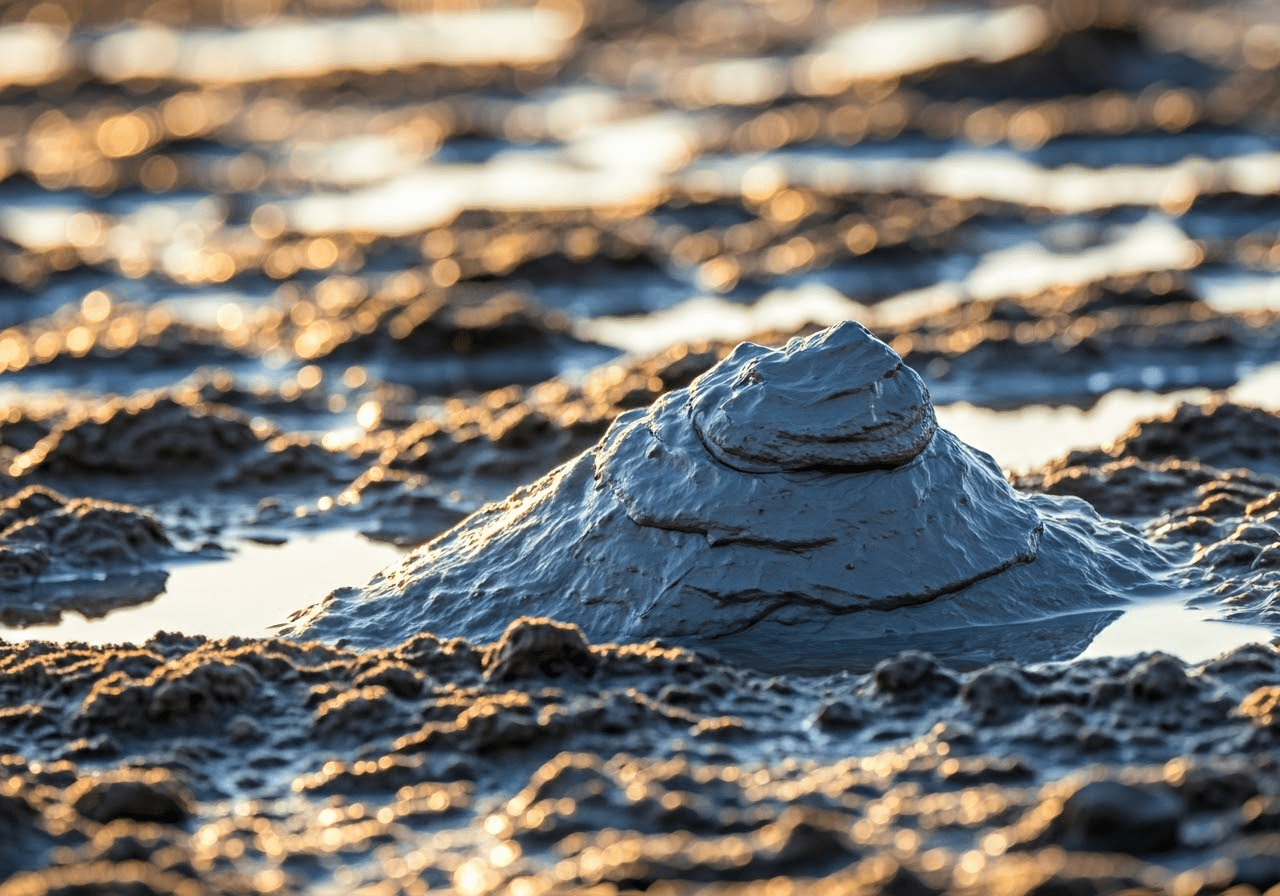Table of Contents
Key Highlights
- Bentonite clay, derived from volcanic ash, effectively seals ponds by expanding when wet and forming an impermeable barrier, thus preventing water leakage.
- Choosing the right type of bentonite, typically sodium bentonite, is crucial, as each type has different properties affecting its sealing ability.
- Factors like soil composition, pond size, and the presence of leaks heavily influence the amount of bentonite required for effective sealing.
- Proper preparation of the pond bed, which includes removing debris and achieving optimal moisture content, is essential for successful bentonite application.
- Regular monitoring of the pond’s water levels and prompt addressing of any leaks can maintain the effectiveness of the bentonite seal in the long run.
Introduction
Keeping a steady water level is very important for anyone who has a pond. Bentonite clay, due to its chemical composition, is a common choice for sealing ponds and stopping expensive water loss. This natural clay soaks up water. When it does, it expands and forms a barrier that keeps leaks from happening. If you know how bentonite clay helps to hold water, check the specific needs of your pond, and learn how to apply it, you can find a good and long-lasting solution for pond sealing.
Understanding Bentonite’s Role in Water Retention

Bentonite is a natural clay made from volcanic ash and has a high clay content. It can soak up water very well. This makes it useful in many areas, and pond sealing is one of the most common ways it’s used. Its great water-absorbing ability comes from its special make-up, mainly made of smectite clay minerals like montmorillonite.
What makes sodium bentonite special is how much it swells. When sodium bentonite meets water, it acts like a sponge, soaking up the water and getting bigger. This growth helps the sodium bentonite fill gaps in the soil. As a result, it creates a thick, impermeable barrier that prevents water seepage. This barrier stops water from leaking out of the pond. Sodium bentonite works well as a pond sealant because it turns the soil into a watertight barrier. This way, the pond keeps water easily.
The Science Behind Bentonite Clay
Sodium bentonite clay works well for pond sealing because of its special chemical makeup and structure. It mostly consists of montmorillonite. This type of clay absorbs a lot of water.
Its effectiveness comes from the way the atoms are arranged in the clay. This arrangement helps water molecules get in between the clay layers. When that happens, the clay layers separate, and the clay swells up. This swelling is important because it allows sodium bentonite to fill small gaps and holes in the soil. This creates a barrier to stop water from leaking through.
Also, the negatively charged surface of the clay layers helps seal even better. These negative charges pull in positively charged ions from the water. This makes the clay bond more tightly with the water and form a solid, impermeable layer.
Comparing Bentonite’s Efficacy to Other Sealing Materials
While several pond sealing materials are available, bentonite clay, especially sodium-based bentonite, stands out for its effectiveness and longevity. Compared to other options like liners and compacted clay, bentonite often proves more cost-effective and environmentally friendly.
Liners, while effective, can be prone to punctures and may require complete replacement if compromised. Compacted clay, on the other hand, can be challenging to install correctly, and its effectiveness depends heavily on the soil quality. Bentonite, with its self-sealing properties, eliminates these concerns.
Here’s a comparative look at different pond sealers:
|
Pond Sealer |
Pros |
Cons |
|
Bentonite Clay |
Cost-effective, Natural, Self-Sealing, Long-lasting |
Requires proper soil preparation, Not suitable for all soil types |
|
Pond Liners |
Highly effective barrier |
Prone to punctures, May require replacement, Can be expensive |
|
Compacted Clay |
Natural option, Relatively inexpensive |
Requires specific soil conditions, Labor-intensive installation |
Evaluating Your Lake Bed’s Need for Bentonite
Before using bentonite, you need to check your lake bed carefully. This check is important. It helps you see if you need bentonite and lets you figure out how much to use.
First, look at the soil in your lake bed. Then, check for signs of water leaking. This could be low water levels, wet spots, or water flowing in visible areas. Knowing these things about your lake bed will help you decide if you should use bentonite and find the best way to seal it.
Assessing Soil Composition and Porosity
The type of clay soil in your lake bed is very important for figuring out if you need bentonite. Soils that have a lot of clay are less porous. This means they hold water better and might not need bentonite. On the other hand, sandy or gravelly soils, which have bigger particles, are more open. This allows water to flow out, so these types of soil usually need bentonite to hold water better.
To check your soil, grab a handful from the lake bed and add a little water. Try to shape it into a ball. If it stays shaped easily, then there is enough clay and a lot of clay in it. If it falls apart, that means there is less clay, and you might need bentonite.
Knowing your local soil conditions is key for keeping your pond healthy. It can help to talk to a local soil expert. They can check your soil material for you. This way, you will know if you need bentonite and how much to use.
Identifying Signs of Water Leakage in Lake Beds
Spotting signs of water leakage in your lake bed is important. This helps you apply bentonite on time. Noticeable water loss, even when it doesn’t rain much, is a big warning sign. If you see your lake’s water level drop a lot without any good reason, it likely means there is excessive seepage.
You should also look for wet areas around the lake. If these places stay damp, even when it is dry, it can mean water is leaking out from the lake bed. Pay attention to areas with unusually green plants. This growth could show that water is moving underground because of leaks.
Ignoring these signs can cause serious water loss. It can also affect the health of your lake’s ecosystem. Finding and fixing leaks quickly is important for keeping a healthy and lively aquatic environment.
Preparing the Lake Bed for Bentonite Application

Properly preparing the lake bed is very important for using bentonite. It helps the bentonite work well over time to seal the lake bed. Before adding bentonite, check that the lake bed is clear of debris like rocks, plants, or any leftover organic matter.
The moisture level in the lake bed is important too. If the soil is too dry, the bentonite may not stick properly. If the lake bed has too much water, the bentonite could wash away before it can form a seal.
Techniques for Cleaning and Smoothing the Surface
Before you put down bentonite, make sure to clean the bottom of the pond and side slopes very well. Get rid of any debris that could interfere with how well the sealant works. Remove rocks, sticks, roots, and any organic material. You want a smooth surface for the bentonite to stick to the soil properly. This cleaning step is very important for a strong and lasting seal.
You can use a rake or a similar tool to take away larger debris quickly. Be careful around corners and edges, as this is where debris can build up. If there are trees or big shrubs close to the pond site, you might want to put in a root barrier. This will stop future roots from breaking the bentonite seal.
Making the surface smooth is just as key as cleaning it. Fill in any holes or uneven spots with packed soil. This will create a flat base for applying the bentonite. A level surface helps spread the sealant evenly, making it work better and avoiding weak spots in the seal.
Optimal Conditions for Bentonite Application
Ensuring the pond area has the optimum moisture content is important for using bentonite successfully. If the soil is dry, you will need to wet it first to get the perfect consistency. Bentonite needs moisture to expand properly. But, if the soil is too wet, it can weaken the bentonite and make it less effective as a sealant. If you notice the soil clinging to your shoes when you walk on it, it is likely too wet. It should dry out before you apply the bentonite.
To get the right moisture, consider watering the pond area one or two days before using the bentonite. This will help the water soak into the soil evenly. You want the soil to be damp, but not soaked.
Always check the weather before you start. If rain is on the way, do not apply the bentonite. Rain can wash away the untreated bentonite.
Bentonite Application Methods for Lake Beds
There are several good ways to apply bentonite to your lake bed. Each method has its own positives and things to think about. The method you pick will depend on the size of your pond, how bad the seepage is, and how easy it is to get to the pond area.
The most popular methods are the blanket method, the mixed blanket method, and the sprinkle method. No matter which method you use, make sure that you spread the bentonite evenly across the whole lake bed. This will help you create a uniform and effective seal.
The Blanket Method Explained
The blanket method is about putting a flat layer of bentonite directly on the lake bed. This creates a barrier that stops water from leaking through. It is very important to make this layer even. The thickness should be between 0.5 and 1 inch for the best outcome. This method is easy to do and works well for new ponds or those that have been fully drained.
Start by spreading the bentonite evenly across the entire pond bottom. Make sure the depth is the same everywhere. It can help to break the pond area into smaller sections. This will help keep everything uniform. After you place the bentonite, add a layer of soil on top.
This soil layer protects the bentonite from damage. It shields it from foot traffic, waves, and aquatic animals. A soil layer that is about 6 to 8 inches deep is enough to protect the layer of bentonite below.
Pros and Cons of the Mixed Blanket Method
The mixed blanket method is about blending bentonite with some existing lake bed soil before using it. This method adds one more step to the application process. However, it leads to a stronger and better seal. It works well where the current soil cannot hold water very well.
Start by spreading the right amount of bentonite evenly across the lake bed. Then, mix the bentonite into the top layer of soil, going about 6 to 8 inches deep. This thorough mixing helps bind the soil particles and improves water retention.
Unlike the sprinkle method, which just scatters dry bentonite on the water surface, the mixed blanket method offers better, even distribution. This method does take more work, especially for bigger ponds. Still, the mixed blanket method is usually preferred for creating a strong and lasting seal.
Aftercare and Maintenance of Bentonite-Treated Lake Beds
After you apply bentonite to your lake bed, it’s very important to take care of it properly. This helps it work well and keeps water for a long time. Check the water level often to make sure the bentonite is doing its job.
Keep the treated area safe from things that might cause problems, such as too much foot traffic or animals which might damage the seal. It’s important to keep the bentonite layer strong to have a healthy and balanced water environment.
Monitoring Water Levels Post-Application
After using bentonite, watch your lake’s water level closely, especially in the first few weeks. It’s important to keep an eye on it during this time. This helps you see how well the bentonite seal is working and if you need to fix anything. Write down the water level and note any big drops or changes.
Some small changes in water level are normal, especially because of things like evaporation. But if the water level keeps going down a lot, it might mean there is a problem with the bentonite seal. This could be due to not using enough bentonite or places where the seal has been disturbed. If you notice a possible leak, find where it’s coming from and add more bentonite if needed.
Also, pay attention to the wave action in your lake. Too much wave action can slowly wear away the pond bottom soil, which can hurt the bentonite layer over time. If this is an issue, think about using some ways to reduce wave action. You could put in a wave barrier or plant plants along the shoreline to help protect against the waves.
Long-Term Maintenance Tips for Optimal Water Retention
Long-term care of a bentonite-treated lake bed is important. It helps keep the sealing process working and supports a healthy water environment. Try to avoid draining the lake unless it is really necessary. If you do drain it, the bentonite might dry out and crack. This can harm its sealing properties. If you must drain, make sure to compact the bentonite layer again before you refill the lake to keep it effective.
Check the water surface often for any oil or fuel spills. These can break down the bentonite over time, making it less effective as a seal. If there are spills, act quickly. Use the right absorbent materials to stop contamination and protect the bentonite layer.
The life of the bentonite seal can change based on things like the type of soil, how good the bentonite is, and factors like temperature changes and water chemistry.
Conclusion
In conclusion, it is very important to keep the water retention ability of a lake bed. This is key for good water management. Bentonite is helpful because it improves the sealing of lake beds. This stops water from leaking out and helps keep water in for a long time. You should check the soil in your lake bed to find any leaks. Then, use bentonite in the right ways. This will boost the water-holding capacity of the lake bed. You should also check and take care of the area after using bentonite. This will help you get the most out of the treatment. If you follow these steps, you can help make best use of your lake bed and save water.
Frequently Asked Questions
How do I calculate the amount of bentonite needed for my lake bed?
To find out how much bentonite you need for your lake bed, you should look at a few important things. These include the pond area, the depth of the pond, and the application rate you want to use. There are online calculators that can help you figure out the right amount of bentonite needed based on these factors.
Can bentonite treatment be applied to an existing filled lake?
It works better to add bentonite to a dry lake bed. However, you can still put it into a filled lake. You just need to spread the right total amount of bentonite across the water surface. Over time, the bentonite will sink down and create a layer of bentonite on the bottom. Keep in mind, this way might not cover everything evenly.


